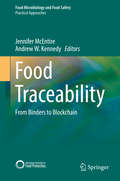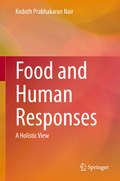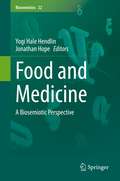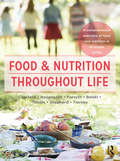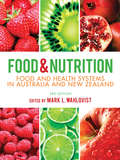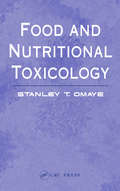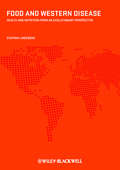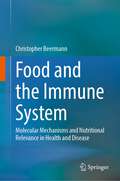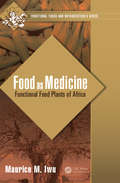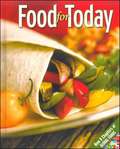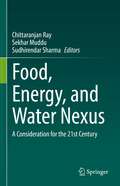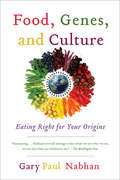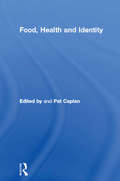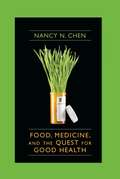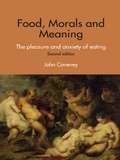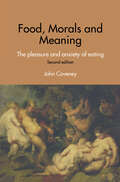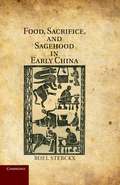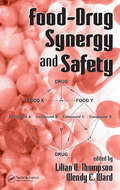- Table View
- List View
Food Traceability: From Binders to Blockchain (Food Microbiology and Food Safety)
by Jennifer McEntire Andrew W. KennedyThis book provides a picture of food traceability for all aspects of the food system, recognizing the unique differences, challenges, and “states of the industry” in different types of food products, as well as the different pressures and opportunities at different points in the supply chain and the research that has already been done. It also provides some historical context, along with the types of solutions available to the food industry, and the benefits associated with better recordkeeping that go beyond the public good and impact the bottom line. Whenever a food related outbreak occurs, traceability is called into question. When lives are at stake, it is critical that the root of the problem is quickly identified to prevent further illness. Once the problem is found, it’s just as important to contain it quickly. Too often, recalls expand because implicated product is not readily accounted for. Mention of traceability stirs fear for many in the food industry for several reasons: within a company, it’s not clear if responsibility for traceability lies with food safety professionals involved in recalls, supply chain professionals who understand product movement, IT professionals who build and maintain the recordkeeping systems, or regulatory professionals who need to respond to government requests for information. There is also a sense that traceability is someone else’s problem. Few firms admit that they are the weak link and instead tout how quickly they can perform mock recalls. But traceability is about more than just recalls. It is about the connectivity of the supply chain as a product and its constituents travel from the farm to the consumer. Because it is a systems issue, there is a sense that the investment by a single firm will be meaningless if supply chain partners don’t have comparable abilities. This book will address both these surrounding issues and solutions.
Food and Human Responses: A Holistic View
by Kodoth Prabhakaran NairThis book discusses the role of food and the human nutrition-behavior interface. Food makes us what we are, but in addition to providing adequate nutrition, does it influence behavior? This book looks at this critical question from various angles and considers different concepts and approaches to food, nutrition and well-being. To better understand the entire gamut of the food-behavior linkage, the author unravels the workings of the mind - brain link. The book discusses this aspect and the findings add to the existing fund of knowledge in this area. Much of today’s malaise in humans can be traced to the food consumed by individuals. This book provides a comprehensive picture of the current state of human nutrition and how this can be linked to behavior.
Food and Medicine: A Biosemiotic Perspective (Biosemiotics #22)
by Jonathan Hope Yogi Hale HendlinThis edited volume provides a biosemiotic analysis of the ecological relationship between food and medicine. Drawing on the origins of semiotics in medicine, this collection proposes innovative ways of considering aliments and treatments. Considering the ever-evolving character of our understanding of meaning-making in biology, and considering the keen popular interest in issues relating to food and medicines - fueled by an increasing body of interdisciplinary knowledge - the contributions here provide diverse insights and arguments into the larger ecology of organisms’ engagement with and transformation through taking in matter. Bodies interpret molecules, enzymes, and alkaloids they intentionally and unintentionally come in contact with according to their pre-existing receptors. But their receptors are also changed by the experience. Once the body has identified a particular substance, it responds by initiating semiotic sequences and negotiations that fulfill vital functions for the organism at macro-, meso-, and micro-scales. Human abilities to distill and extract the living world into highly refined foods and medicines, however, have created substances far more potent than their counterparts in our historical evolution. Many of these substances also lack certain accompanying proteins, enzymes, and alkaloids that otherwise aid digestion or protect against side-effects in active extracted chemicals. Human biology has yet to catch up with human inventions such as supernormal foods and medicines that may flood receptors, overwhelming the body’s normal satiation mechanisms. This volume discusses how biosemioticians can come to terms with these networks of meaning, providing a valuable and provocative compendium for semioticians, medical researchers and practitioners, sociologists, cultural theorists, bioethicists and scholars investigating the interdisciplinary questions stemming from food and medicine.
Food and Mental Health: A Guide for Health Professionals
by Gerrie HughesWritten by an experienced psychotherapist, this book provides professionals in the fields of health and wellbeing with a guide to human relationships with food, and their impact on mental health. Acknowledging how food choices profoundly effect a person’s experience in the world, Gerrie Hughes offers knowledge and support around how to understand and negotiate the relationship between food and mind. Chapters offers facts, information and theories on key topics such as self-image, ‘good’ nutrition, sustainability and rituals. Each chapter uses vignettes, case studies and reflective activities to stimulate thought about the reader’s own assumptions and experience and offer approaches to how they might use their expertise with the people with whom they work. Providing an accessible and easy to read guide into the role food plays in our lives, this book will be of interest to a range of healthcare practitioners, including mental health nurses, occupational therapists, psychotherapists, and counsellors.
Food and Nutrition Throughout Life: A comprehensive overview of food and nutrition in all stages of life
by Sue Shepherd Regina Belski Adrienne Forsyth Catherine Itsiopoulos Antonia Thodis Audrey Tierney Sharon CroxfordNutritional requirements vary greatly according to age and lifestyle. This evidence-based, comprehensive text is a complete guide to eating habits across age and population groups. It provides the recommendations for intakes of nutrients and foods, and diet to achieve optimum health.Chapters systematically examine the nutritional issues for individuals from preconception, pregnancy and breastfeeding through to adulthood and old age. The text features an overview of dietary patterns by age group based on national scientific survey data together with the latest recommendations for optimum nutrition to maintain well-being and address specific health concerns. The final section examines nutrition issues for specific populations including indigenous groups, athletes and the disadvantaged. Throughout the text, key points are illustrated by case studies and the reader's knowledge is tested via quizzes and study questions.With chapters from leading nutrition researchers and educators in Australia, New Zealand and Asia, this is an excellent introduction to nutrition through the lifespan.'A comprehensive overview and detailed discussion of food and nutrition topics for all ages and stages of life.' - Robynne Snell, Curtin University
Food and Nutrition: Food and health systems in Australia and New Zealand
by Jan Payne Janis Baines Danielle Gallegos Mark L. Wahlqvist Madeleine Ball Jonathan M. Hodgson Gwyn P. Jones Antigone Kouris-Blazos Louise B. Lennard Ingrid H.E. Rutishauser Gayle S. Savige Kelly L. Stewart Naiyana WattanapenpaiboonMark Wahlqvist's Food and Nutrition is widely regarded as the most authoritative introduction to nutrition and dietetics in the region. It provides a comprehensive overview of nutrition needs at different life stages, the biochemistry of foods, dietary disorders, and the social, political and environmental contexts of food production and consumption.This third edition has been completely revised and significantly expanded to encompass recent developments in nutritional science, technology and policy. It includes new material on genetics, regulation, food production, birth weight, lifestyle and cancer, and the implications of climate change for food production, safety and availability. Chapters are extensively illustrated with data and diagrams.The book is divided into the following sections:* Human nutrition* Food systems, security and policy* The biology of food components* Lifespan nutrition* Food and disease* Food and nutrition for individuals and societyWith chapters from leading nutritionists, Food andNutrition is an indispensable student text and a valuable professional reference.
Food and Nutritional Toxicology
by Stanley T. OmayeFood and Nutritional Toxicology provides a broad overview of the chemicals in food that have the potential to produce adverse health effects. The book covers the impact on human health of food containing environmental contaminants or natural toxicants, food additives, the migration of chemicals from packaging materials into foods, and the persisten
Food and Western Disease: Health and Nutrition from an Evolutionary Perspective
by Staffan LindebergNutrition science is a highly fractionated, contentious field with rapidly changing viewpoints on both minor and major issues impacting on public health. With an evolutionary perspective as its basis, this exciting book provides a framework by which the discipline can finally be coherently explored. By looking at what we know of human evolution and disease in relation to the diets that humans enjoy now and prehistorically, the book allows the reader to begin to truly understand the link between diet and disease in the Western world and move towards a greater knowledge of what can be defined as the optimal human diet. Written by a leading expert Covers all major diseases, including cancer, heart disease, obesity, stroke and dementia Details the benefits and risks associated with the Palaeolithic diet Draws conclusions on key topics including sustainable nutrition and the question of healthy eating This important book provides an exciting and useful insight into this fascinating subject area and will be of great interest to nutritionists, dietitians and other members of the health professions. Evolutionary biologists and anthropologists will also find much of interest within the book. All university and research establishments where nutritional sciences, medicine, food science and biological sciences are studied and taught should have copies of this title.
Food and the Immune System: Molecular Mechanisms and Nutritional Relevance in Health and Disease
by Christopher BeermannNutrition is an important environmental factor for the maturation of the human immune system and essential for maintaining immunological homeostasis. Based on this, a variety of food applications with medical claims are being generated by food manufacturers worldwide in order to expand the market potential of products creating interesting linkages with other market segments, such as cosmetics and pharmaceuticals. However, in addition to the health benefits, active principles of such components often remain unexplored.This book focusses on the specific interactions between food ingredients and the immune system along the entire immune defense response. Starting from the immune barrier, through the innate and adaptive immune response, to active limitation and termination, all major mechanisms of the immune response are addressed and different biochemical, cellular and genetic interactions of components of our diet are discussed. The book presents a wealth of disease patterns for which nutritional factors are relevant and thereby provides indications for potential intervention strategies. In addition, associated food-technological aspects are discussed. Being the first of its kind, this book provides an overview of the variety of functional food components and their influence on immunological responses. Written in an accessible style, it addresses researchers, health professionals and students with different scientific backgrounds.
Food as Medicine: Functional Food Plants of Africa (Functional Foods and Nutraceuticals)
by Maurice M. IwuThis comprehensive book documents African plants used for functional and medicinal foods. It contains more than 60 detailed monographs of African foods, describing foods with various characteristics such as prebiotic, probiotic, satiety, immune modulation, stress-reduction, sports performance, mental acuity, sleep-supporting, metabolic syndrome, antioxidant, and unsaturated fats. Plant description, botanical names and synonyms, plant part used, habitat and distribution, folk use, nutritional content, and chemistry are all fully detailed. The book highlights indigenous African food processing technologies up to the modern era.
Food for Thought: The Integrated Practitioner
by Justin AmeryEverything that exists, exists against a background. All of our experiences, beliefs and understandings of health practice derive from a living, organic and constantly moving context: whether scientific, philosophical, cultural, aesthetic, biological or spiritual. It is useful therefore to spend a little time understanding and reflecting on these building blocks of who we are. As practitioners, we don't always have time to do this...A little luxury...not essential, but hopefully a bit nourishing. Like a fireside cup of cocoa. - Justin Amery This extraordinary new series fills a void in practitioner development and well-being. The books take a reflective step back from the tick-box, target-driven and increasingly regulated world of 21st century health practice; and invite us to revisit what health and health practice actually are. Building carefully on the science and philosophy of health, each book addresses the messy, complex and often chaotic world of real-life health practice and offers an ancient but now almost revolutionary understanding for students and experienced practitioners alike: that health practice is a fundamentally creative and compassionate activity. The series as a whole helps practitioners to redefine and recreate their daily practice in ways that are healthier for both patients and practitioners. The books provide a welcome antidote to demoralisation and burn-out amongst practitioners, reversing cynicism and reviving our feeling of pride in, and our understanding of, health practice. By observing practice life through different lenses, they encourage the development of efficiency, effectiveness and, above all, satisfaction. The fifth book in this series, The Integrated Practitioner: Food for Thought, written for readers who prefer a more academic and reflective understanding of the themes of books 1-4.
Food for Today
by Glencoe Mcgraw-HillTreat students to the best and most comprehensive foods textbook with Glencoe's Food for Today! Content is based on the latest research-based nutrition to develop lifelong healthy eating habits. Numerous illustrations, step-by-step activities, and visualization of correct portions are included. All new FACS standards for the foods classroom are met. Focus on food prep and kitchen basics include kitchen tools, safety, and sanitation. Topic-related and point-of-use academic integration with Science in Action and Kitchen Math features help teachers meet Perkins mandates. English language arts and writing activities correlated to national standards. New and revised focus on light and healthy recipes. International recipes are provided. Activities that develop consumer savvy about food choices, nutrition, and keeping a grocery budget are incorporated. Hands-on Kitchen Lab and unit-long projects reinforce concepts through application.
Food for Today (9th edition)
by Helen KowtalukA comprehensive lab-based foods and nutrition program for high school students. It is correlated to the National Standards for Family & Consumer Sciences. Students learn how to make healthy and nutritious food decisions reflecting the most current nutritional guidelines, how to plan meals safely, how to prepare food, how to appreciate food diversity, how science and technology impact foods and nutrition, and about career opportunities in the area of foods and nutrition.
Food, Ecology and Culture: Readings in the Anthropology of Dietary Practices (Food and Nutrition in History and Anthropology)
by J. R. K. RobsonFirst published in 1980. Routledge is an imprint of Taylor & Francis, an informa company.
Food, Energy, and Water Nexus: A Consideration for the 21st Century
by Chittaranjan Ray Sekhar Muddu Sudhirendar SharmaIn this book, major issues surrounding importance of water and energy for food security in the United States and India are described representing two extremes in yield, irrigation efficiency, and automation. The farming systems in these two countries face different risks in terms of climatic shifts and systems’ resiliency to handle the shocks. One may have comparative advantage over the other, but both are susceptible. Innovations in irrigation for food and fuel production, improvements in nitrogen and water use efficiency, and rural sociological issues are discussed here. We also look into some of the unintended consequences of high productivity agriculture in terms of surface and ground water quality and impacts on ecosystem services. Finally, we present ways to move forward to meet the food demands in the next half-century in both countries. As the current world population of 7 billion is expected to reach or exceed 10 billion in the next 40 years, there will be significant additional demand for food. A rising middle class and its preference for a meat-based diet also increases the demand for animal feed. This additional food and feed production needs special considerations in water and energy management besides the development of appropriate crop hybrids to withstand future climatic shifts and other environmental factors. A resilient agricultural landscapes will also be needed to withstand climatic fluctuations, disease pressures, etc. While the upper and many middle income countries have made significant improvements in crop yield due to pressurized irrigation and automation in farming systems, the lower income countries are struggling with yield enhancements due to such limitations. The rise in population is expected to be more in Sub-Sharan Africa and Middle East (Low to middle-income countries) where the crop yields are expected to be low.
Food, Genes, and Culture: Eating Right for Your Origin
by Gary Paul NabhanVegan, low fat, low carb, slow carb: Every diet seems to promise a one-size-fits-all solution to health. But they ignore the diversity of human genes and how they interact with what we eat. In Food, Genes, and Culture, renowned ethnobotanist Gary Nabhan shows why the perfect diet for one person could be disastrous for another. If your ancestors were herders in Northern Europe, milk might well provide you with important nutrients, whereas if you're Native American, you have a higher likelihood of lactose intolerance. If your roots lie in the Greek islands, the acclaimed Mediterranean diet might save your heart; if not, all that olive oil could just give you stomach cramps. Nabhan traces food traditions around the world, from Bali to Mexico, uncovering the links between ancestry and individual responses to food. The implications go well beyond personal taste. Today's widespread mismatch between diet and genes is leading to serious health conditions, including a dramatic growth over the last 50 years in auto-immune and inflammatory diseases. Readers will not only learn why diabetes is running rampant among indigenous peoples and heart disease has risen among those of northern European descent, but may find the path to their own perfect diet.
Food, Health and Identity
by Pat CaplanBy addressing the issue of food and eating in Britain today this collection considers the ways in which food habits are changing and shows how social and personal identities and perceptions of health risk influence people's food choices.The articles explore, among other issues:• the family meal• wedding cakes• nostalgia and the invention of tradition• the rise of vegetarianism• the recent BSE crisis• the `creolization' of British food eating out• creation of individual identity through lifestyle.The contributors include Hanna Bradby, Simon Charsley, Allison James, Anne Keane, Lydia Martens and Alan Warde.
Food, Medicine, and the Quest for Good Health
by Chen Nancy N.Drawing on medical texts and food therapy practices from around the world and throughout history, Nancy N. Chen locates old and new crossovers between food and medicine in different social and cultural contexts.
Food, Medicine, and the Quest for Good Health: Nutrition, Medicine, and Culture
by Nancy ChenWhat we eat, how we eat, where we eat, and when we eat are deeply embedded cultural practices. Eating is also related to how we medicate. The multimillion-dollar diet industry offers advice on how to eat for a better body and longer life, and avoiding harmful foods (or choosing healthy ones) is considered separate from consuming medicine-another multimillion-dollar industry. In contrast, most traditional medical systems view food as inseparable from medicine and regard medicinal foods as the front line of healing. Drawing on medical texts and food therapy practices from around the world and throughout history, Nancy N. Chen locates old and new crossovers between food and medicine in different social and cultural contexts. The consumption of spices, sugar, and salt was once linked to specific healing properties, and trade in these commodities transformed not just the political economy of Europe, Asia, and the New World but local tastes and food practices as well. Today's technologies are rapidly changing traditional attitudes toward food, enabling the cultivation of new admixtures, such as nutraceuticals and genetically modified food, that link food to medicine in novel ways. Chen considers these developments against the evolving food regimes of the diet industry in order to build a framework for understanding diet as individual practice, social prescription, and political formation.
Food, Morals and Meaning: The Pleasure and Anxiety of Eating
by John CoveneyFollowing on from the success of the first edition, John Coveney traces our complex relationship with food and eating and our preoccupation with diet, self-discipline and food guilt. Using our current fascination with health and nutrition, he explores why our appetite for food pleasures makes us feel anxious. This up-to-date edition includes an examination of how our current obsession with body size, especially fatness, drives a national and international panic about the obesity ‘epidemic’. Focusing on how our food anxieties have stemmed from social, political and religious problems in Western history, Food, Morals and Meaning looks at: the ancient Greeks’ preoccupation with eating early Christianity and the conflict between the pleasures of the flesh and spirituality scientific developments in eighteenth and nineteenth century Europe and our current knowledge of food the social organization of food in the modern home, based on real interviews the obesity ‘epidemic’ and its association with moral degeneration. Based on the work of Michel Foucault, this fresh and updated edition explains how a rationalization food choice – so apparent in current programmes on nutrition and health – can be traced through a genealogy of historical social imperatives and moral panics. Food, Morals and Meaning is essential reading for those studying nutrition, public health, sociology of health and illness and sociology of the body.
Food, Morals and Meaning: The Pleasure and Anxiety of Eating
by John CoveneyFirst published in 2006. Food, Morals and Meaning examines our need to discipline our desires, our appetites and our pleasures at the table. However, instead of seeing this discipline as dominant or oppressive it argues that a rationalisation of pleasure plays a positive role in our lives, allowing us to better understand who we are. The book begins by exploring the way that concerns about food, the body and pleasure were prefigured in antiquity and then how these concerns were recast in early Christianity as problems of 'natural' appetite which had to be curbed. The following chapters discuss how scientific knowledge about food was constructed out of philosophical and religious concerns about indulgence and excess in 18th and 19th Century Europe. Finally, by using research collected from in-depth interviews with families, the last section focuses on the social organisation of food in the modern home to illustrate the ways that the meal table now incorporates the principles of nutrition as a form of moral training, especially for children. Food, Morals and Meaning will be essential reading for those studying nutrition, public health, sociology of health and illness and sociology of the body.
Food, Sacrifice, and Sagehood in Early China
by Roel SterckxIn ancient China, the preparation of food and the offering up of food as a religious sacrifice were intimately connected with models of sagehood and ideas of self-cultivation and morality. Drawing on received and newly excavated written sources, Roel Sterckx's book explores how this vibrant culture influenced the ways in which the early Chinese explained the workings of the human senses, and the role of sensory experience in communicating with the spirit world. The book, which begins with a survey of dietary culture from the Zhou to the Han, offers intriguing insights into the ritual preparation of food - some butchers and cooks were highly regarded and would rise to positions of influence as a result of their culinary skills - and the sacrificial ceremony itself. As a major contribution to the study of early China and to the development of philosophical thought, the book will be essential reading for students of the period, and for anyone interested in ritual and religion in the ancient world.
Food-Drug Synergy and Safety
by Lilian U. Thompson Wendy E. WardScientists, health professionals, and consumers are increasingly interested in the relationships between food components and food-drug combinations as they strive to find more effective ways to prevent or treat chronic disease. As one of the first unified and in-depth sources in this emerging topic, Food-Drug Synergy and Safety explores the vast po
Foodborne Disease and Public Health: SUMMARY OF AN IRANIAN-AMERICAN WORKSHOP
by Institute of Medicine National Research Council of the National AcademiesThe Institute of Medicine's Food and Nutrition Board and the National Research Council's Policy and Global Affairs Division convened a workshop in Washington, D.C., entitled Foodborne Disease and Public Health: An Iranian-American Workshop. The overall goals of this workshop were to facilitate the exchange of ideas about foodborne disease and public health and to promote further collaboration among Americans and Iranians on this topic of mutual interest. Experts invited to participate in this workshop addressed a variety of topics, ranging from the surveillance of outbreaks of foodborne illness to approaches to medical training in the Iranian and U.S. educational systems. The workshop was part of a series of cooperative efforts between the United States and Iran as the two countries have collaborated in the past on similar projects relating to foodborne disease.
Foodborne Microbial Pathogens: Mechanisms And Pathogenesis (Food Science Text Ser.)
by Arun K. BhuniaThis book primarily covers the general description of foodborne pathogens and their mechanisms of pathogenesis, control and prevention, and detection strategies, with easy-to-comprehend illustrations. The book is an essential resource for food microbiology graduate or undergraduate students, microbiology professionals, and academicians involved in food microbiology, food safety, and food defense-related research or teaching. This new edition covers the significant progress that has been made since 2008 in understanding the pathogenic mechanism of some common foodborne pathogens, and the host-pathogen interaction. Foodborne and food-associated zoonotic pathogens, responsible for high rates of mortality and morbidity, are discussed in detail. Chapters on foodborne viruses, parasites, molds and mycotoxins, and fish and shellfish are expanded. Additionally, chapters on opportunistic and emerging foodborne pathogens including Nipah virus, Ebola virus, Aeromonas hydrophila, Brucella abortus, Clostridium difficile, Cronobacter sakazakii, and Plesiomonas shigelloides have been added. The second edition contains more line drawings, color photographs, and hand-drawn illustrations.
